The Implant-Borne Prosthetics Market is estimated to be valued at USD 5.3 billion in 2025 and is projected to reach USD 11.5 billion by 2035, registering a compound annual growth rate (CAGR) of 8.1% over the forecast period.
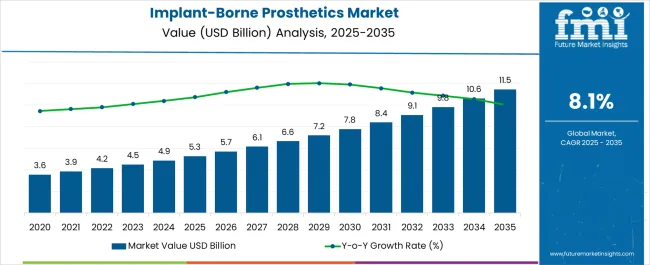
| Metric | Value |
|---|---|
| Implant-Borne Prosthetics Market Estimated Value in (2025 E) | USD 5.3 billion |
| Implant-Borne Prosthetics Market Forecast Value in (2035 F) | USD 11.5 billion |
| Forecast CAGR (2025 to 2035) | 8.1% |
The Implant-Borne Prosthetics market is witnessing significant growth, driven by the increasing demand for advanced dental and orthopedic solutions that restore functionality and improve patient quality of life. Rising incidences of tooth loss, bone degeneration, and musculoskeletal disorders are contributing to the need for reliable implant solutions. Adoption is further supported by technological advancements in prosthetic design, surgical techniques, and materials science, which enhance durability, biocompatibility, and patient comfort.
Screw-retained and bone level prosthetics have gained traction due to their precision, stability, and long-term performance. Titanium and other high-strength materials provide structural integrity while promoting osseointegration, which is critical for successful implantation. The integration of digital dentistry, 3D imaging, and computer-assisted surgical planning is improving procedural accuracy and reducing recovery times.
Growing awareness among healthcare providers and patients, along with favorable reimbursement policies, is further supporting market expansion As clinical outcomes improve and adoption rises in both developed and emerging regions, the market is expected to experience sustained growth over the coming decade.
The implant-borne prosthetics market is segmented by product type, modality, material, end user, and geographic regions. By product type, implant-borne prosthetics market is divided into Bone Level Prosthetics and Tissue Level Prosthetics. In terms of modality, implant-borne prosthetics market is classified into Screw-Retained, Cement-Retained, Removable, and Fixed. Based on material, implant-borne prosthetics market is segmented into Titanium, Zirconium, Ceramic, and Others. By end user, implant-borne prosthetics market is segmented into Hospitals and Dental Clinics. Regionally, the implant-borne prosthetics industry is classified into North America, Latin America, Western Europe, Eastern Europe, Balkan & Baltic Countries, Russia & Belarus, Central Asia, East Asia, South Asia & Pacific, and the Middle East & Africa.
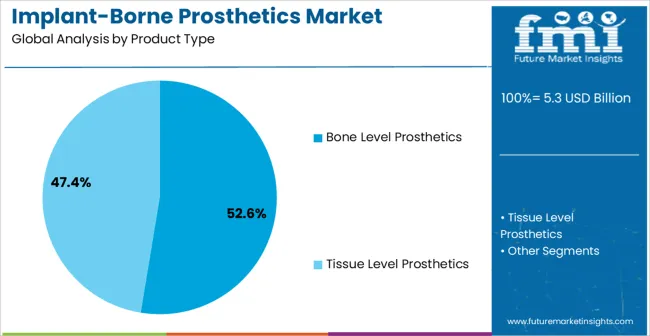
The bone level prosthetics segment is projected to hold 52.6% of the market revenue in 2025, establishing it as the leading product type. Its dominance is being driven by the ability to provide precise fit, stability, and long-term durability in dental and orthopedic implant procedures.
These prosthetics are preferred for their compatibility with screw-retained and cement-retained modalities, allowing flexibility in clinical applications. Advanced manufacturing techniques and digital workflows enhance customization, ensuring patient-specific solutions that improve functional and aesthetic outcomes.
The high success rates in osseointegration and reduced risk of complications have reinforced clinical adoption As demand for reliable, efficient, and scalable implant solutions continues to rise, bone level prosthetics are expected to maintain their leadership, supported by ongoing innovations in design, material selection, and surgical techniques, ensuring improved patient satisfaction and procedural predictability.
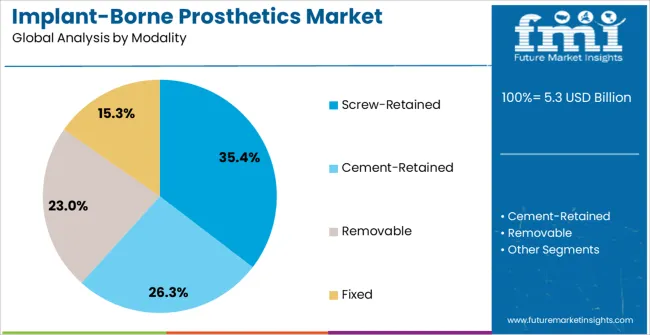
The screw-retained modality segment is expected to account for 35.4% of the market revenue in 2025, making it the leading modality. Growth is being driven by its precision, retrievability, and strong retention, which enhance clinical outcomes and procedural flexibility. This modality allows for easy maintenance and adjustment of prosthetic components without compromising implant stability, reducing long-term complications.
It is widely preferred in complex dental reconstructions and orthopedic applications due to predictable load distribution and reduced stress on surrounding bone. Technological advancements in digital planning, guided surgery, and precision instrumentation have improved the accuracy and efficiency of screw-retained prosthetics.
Rising adoption among clinicians and growing patient awareness of minimally invasive and reliable implant solutions further reinforce its market position As implant procedures become increasingly standardized and technologically enabled, the screw-retained modality segment is expected to sustain its market leadership and drive continued growth.
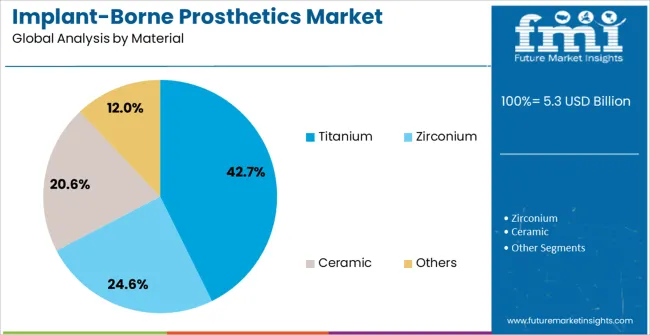
The titanium material segment is projected to hold 42.7% of the market revenue in 2025, establishing it as the leading material. Its growth is being driven by superior biocompatibility, mechanical strength, and corrosion resistance, which are critical for long-term implant stability and osseointegration. Titanium enables durable and lightweight prosthetics, ensuring patient comfort while withstanding functional loads in dental and orthopedic applications.
Surface treatments and alloying techniques further enhance integration with bone tissue, reducing the risk of implant failure. The ability to combine titanium with advanced manufacturing processes, such as 3D printing and precision machining, allows for customized prosthetic designs that meet patient-specific anatomical requirements.
Growing adoption by clinicians, increasing awareness of implant reliability, and favorable clinical outcomes support continued expansion As demand for high-performance, durable, and safe implant materials increases, titanium is expected to remain the material of choice, reinforcing its leadership position in the market.
The increased use of Implant-borne prosthetics in dental implant grow rapidly due to the treatment of choice to replace missing teeth in partially edentulous areas. The fundamental process involved in implant-borne prosthetics is basically depended on the restoring a dental implant by connecting the implant to the crown of the replaced tooth.
There are two main technology used to manufactured and designed the implants such standard prefabricated prosthetic and CAD/Cam. Bone level prosthetics and tissue level prosthetic is the major streamline implant-borne prosthetic type. Innovation in the implant borne prosthetic market gives the comfort, durability, reliability, and precision which further boost the market growth over the forecast period.
The implant-borne prosthetic framework can be tailor-made to the patient specific requirement which also assists the growth of the implant-borne prosthetic market. The material used in implant-borne prosthetic also plays an important role to fuel the market.
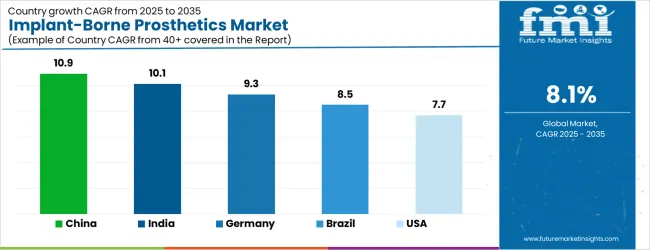
| Country | CAGR |
|---|---|
| China | 10.9% |
| India | 10.1% |
| Germany | 9.3% |
| Brazil | 8.5% |
| USA | 7.7% |
| UK | 6.9% |
| Japan | 6.1% |
The Implant-Borne Prosthetics Market is expected to register a CAGR of 8.1% during the forecast period, exhibiting varied country level momentum. China leads with the highest CAGR of 10.9%, followed by India at 10.1%. Developed markets such as Germany, France, and the UK continue to expand steadily, while the USA is likely to grow at consistent rates. Japan posts the lowest CAGR at 6.1%, yet still underscores a broadly positive trajectory for the global Implant-Borne Prosthetics Market. In 2024, Germany held a dominant revenue in the Western Europe market and is expected to grow with a CAGR of 9.3%. The USA Implant-Borne Prosthetics Market is estimated to be valued at USD 1.9 billion in 2025 and is anticipated to reach a valuation of USD 1.9 billion by 2035. Sales are projected to rise at a CAGR of 0.0% over the forecast period between 2025 and 2035. While Japan and South Korea markets are estimated to be valued at USD 263.3 million and USD 180.6 million respectively in 2025.
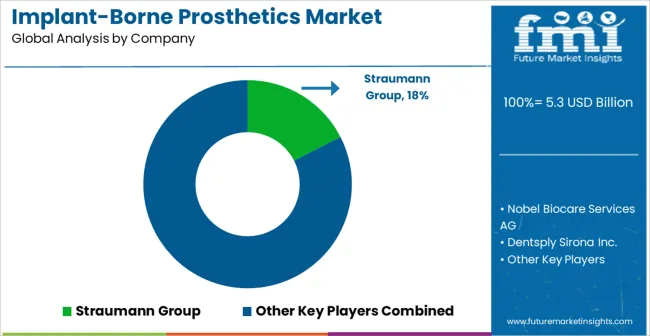
| Item | Value |
|---|---|
| Quantitative Units | USD 5.3 Billion |
| Product Type | Bone Level Prosthetics and Tissue Level Prosthetics |
| Modality | Screw-Retained, Cement-Retained, Removable, and Fixed |
| Material | Titanium, Zirconium, Ceramic, and Others |
| End User | Hospitals and Dental Clinics |
| Regions Covered | North America, Europe, Asia-Pacific, Latin America, Middle East & Africa |
| Country Covered | United States, Canada, Germany, France, United Kingdom, China, Japan, India, Brazil, South Africa |
| Key Companies Profiled | Straumann Group, Nobel Biocare Services AG, Dentsply Sirona Inc., Zimmer Biomet Holdings, Inc., Osstem Implant Co., Ltd., BioHorizons IPH, Inc., Bicon, LLC, CAMLOG Biotechnologies GmbH, Neoss Limited, Anthogyr SAS, MegaGen Implant Co., Ltd., and Dentium Co., Ltd. |
The global implant-borne prosthetics market is estimated to be valued at USD 5.3 billion in 2025.
The market size for the implant-borne prosthetics market is projected to reach USD 11.5 billion by 2035.
The implant-borne prosthetics market is expected to grow at a 8.1% CAGR between 2025 and 2035.
The key product types in implant-borne prosthetics market are bone level prosthetics and tissue level prosthetics.
In terms of modality, screw-retained segment to command 35.4% share in the implant-borne prosthetics market in 2025.






Our Research Products

The "Full Research Suite" delivers actionable market intel, deep dives on markets or technologies, so clients act faster, cut risk, and unlock growth.

The Leaderboard benchmarks and ranks top vendors, classifying them as Established Leaders, Leading Challengers, or Disruptors & Challengers.

Locates where complements amplify value and substitutes erode it, forecasting net impact by horizon

We deliver granular, decision-grade intel: market sizing, 5-year forecasts, pricing, adoption, usage, revenue, and operational KPIs—plus competitor tracking, regulation, and value chains—across 60 countries broadly.

Spot the shifts before they hit your P&L. We track inflection points, adoption curves, pricing moves, and ecosystem plays to show where demand is heading, why it is changing, and what to do next across high-growth markets and disruptive tech

Real-time reads of user behavior. We track shifting priorities, perceptions of today’s and next-gen services, and provider experience, then pace how fast tech moves from trial to adoption, blending buyer, consumer, and channel inputs with social signals (#WhySwitch, #UX).

Partner with our analyst team to build a custom report designed around your business priorities. From analysing market trends to assessing competitors or crafting bespoke datasets, we tailor insights to your needs.
Supplier Intelligence
Discovery & Profiling
Capacity & Footprint
Performance & Risk
Compliance & Governance
Commercial Readiness
Who Supplies Whom
Scorecards & Shortlists
Playbooks & Docs
Category Intelligence
Definition & Scope
Demand & Use Cases
Cost Drivers
Market Structure
Supply Chain Map
Trade & Policy
Operating Norms
Deliverables
Buyer Intelligence
Account Basics
Spend & Scope
Procurement Model
Vendor Requirements
Terms & Policies
Entry Strategy
Pain Points & Triggers
Outputs
Pricing Analysis
Benchmarks
Trends
Should-Cost
Indexation
Landed Cost
Commercial Terms
Deliverables
Brand Analysis
Positioning & Value Prop
Share & Presence
Customer Evidence
Go-to-Market
Digital & Reputation
Compliance & Trust
KPIs & Gaps
Outputs
Full Research Suite comprises of:
Market outlook & trends analysis
Interviews & case studies
Strategic recommendations
Vendor profiles & capabilities analysis
5-year forecasts
8 regions and 60+ country-level data splits
Market segment data splits
12 months of continuous data updates
DELIVERED AS:
PDF EXCEL ONLINE
Prosthetics and Orthotics Market - Growth & Future Trends 2025 to 2035
Competitive Overview of Neuroprosthetics Companies
Passive Prosthetics Market
Orthopedic Prosthetics Market Size and Share Forecast Outlook 2025 to 2035
Upper Limb Prosthetics Market Size and Share Forecast Outlook 2025 to 2035
3D Printed Prosthetics Market Size and Share Forecast Outlook 2025 to 2035
Intelligent Prosthetics Market Analysis - Size, Share, and Forecast 2025 to 2035
Genitourinary Prosthetics Market Size and Share Forecast Outlook 2025 to 2035
Veterinary Orthotics-Prosthetics Market Growth – Trends & Forecast 2025 to 2035
Carbon Fiber Composites for Prosthetics Market 2025-2035
Demand for Carbon Fiber Composites for Prosthetics in Japan Size and Share Forecast Outlook 2025 to 2035

Thank you!
You will receive an email from our Business Development Manager. Please be sure to check your SPAM/JUNK folder too.
Chat With
MaRIA